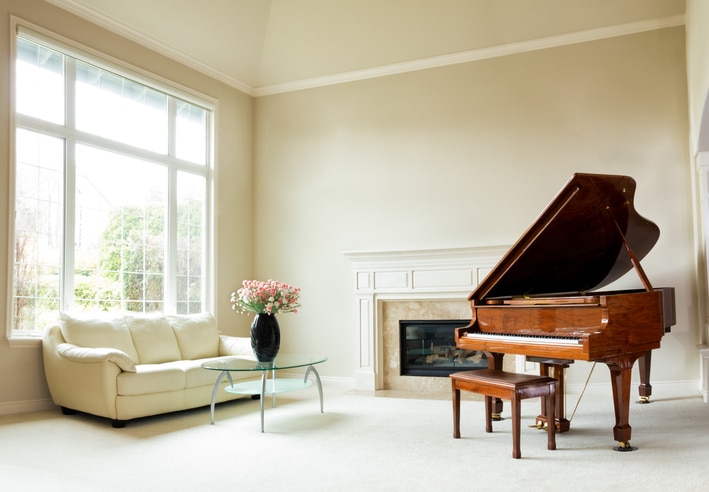Moving a piano is hard, but bringing a piano upstairs presents another level of difficulty. Navigating the instrument’s massive weight and bulky size up a flight of stairs, whether short or long, presents a big challenge for everyone who tries to attempt it.
To ensure everyone’s safety, it is crucial to keep some things in mind before you dive into this undertaking. Read on and learn more about how to move your piano from its current place to the next floor.
1. Plan the Moving Route Ahead
Before you even attempt to move the piano, you need to plan its route upstairs first. This step is essential because it helps you visualize the entire moving process and identify potential hazards. Some of the issues you might run into include blocking furniture, loose rugs and carpets, narrow hallways and staircases, and hanging decorations.
Hence, make sure to address all of these potential hazards first before moving day. You can start out by moving the furniture to another place. Next, bring down the paintings and picture frames that are hanging on the wall. Make sure there are no loose wires on the moving route. Additionally, remove any hanging frames and ornaments on the walls.
By addressing these issues, you help ensure a smoother and easier move for your piano later on. Moreover, it helps determine if you can accomplish the task without professional assistance.
2. Get the Necessary Equipment
Moving a piano upstairs is not only challenging but also dangerous. The piano, for example, may slip from the movers’ grasp and slide down the staircase. Thus, make sure to acquire the necessary moving equipment beforehand.
The items you need to have with you on moving day include:
- Moving dolly — A sturdy dolly is an essential tool for a piano move. If you can, try to secure a dolly designed for carrying pianos. If you can’t find or get a piano dolly, make sure to find a sturdy alternative instead.
- Moving blankets — Moving blankets will protect your piano from harm as it moves to its new spot in the house. It will prevent scratches, dents, and other forms of damage to the piano’s wood and finish. Moreover, it will protect the movers’ hands from getting stuck inside the piano’s crevices.
- Moving straps — These straps will secure the piano in place and keep it in one piece on the dolly. Opt for sturdier and thicker straps that can bear the bulk and weight of the piano. After all, the last thing you want is a strap snapping in half while the piano is on its way up the stairs.
- Packing or duct tape — Taping the moving blankets and straps adds another measure of safety to the whole moving process. It will help make sure that the piano package stays in place and won’t come apart as it goes up the stairs.
- Wooden planks — They will form the makeshift ramp on the stairs, where the dolly will pass through. Make sure to ask the store for plywood planks, which are durable enough to bear a piano’s weight. If you can, get a wider plank that fits the dolly and staircase. If you can’t, buy multiple planks to piece together into a single ramp.
- Heavy-duty gloves — Make sure that each mover has one pair of heavy-duty gloves. It will help the movers have a better grip on the piano and prevent it from slipping.
3. Secure the Piano Properly
The piano needs to be properly prepped before it goes up the stairs. First, make sure to put the keyboard lid and cover down and tape them shut. If there are any pieces to be disassembled, like the legs, remove them properly and set them aside.
Next, wrap the piano with one or two moving blankets and tape it in place. If the piano has moving handles, leave those uncovered. Place the piano on the dolly and strap it in place. Make sure to tighten the straps to ensure that the instrument is secure on the dolly.

4. Prep the Stairs for the Dolly
Before moving the piano, put up the wooden ramp on the stairs. Ideally, you have a wider plywood plank set in place. If not, you can always piece together multiple planks to form a single ramp. There are many ways to go about this. You can take the time to screw and hammer them. With that said, since you may end up using the ramp only once, you can opt to duct tape them together instead.
5. Get Assistance or Hire Help
Moving a piano up the stairs is at least a two-man job: one person to pull the dolly up and another one to push it. This, however, only applies to smaller pianos.
Bringing bigger pianos upstairs takes a lot more manpower. You need to have at least two or more people with you. The more people you have to help you, the better.
No matter how many people you get on board to help with the move, it’s crucial to figure out when you need help from the pros. If moving the piano seems too risky to do on your own or you’re handling an extremely expensive piano, search for piano movers in your area. Don’t compromise your safety and your piano’s condition. Find the right help, and watch your piano go up those steps smoothly.






